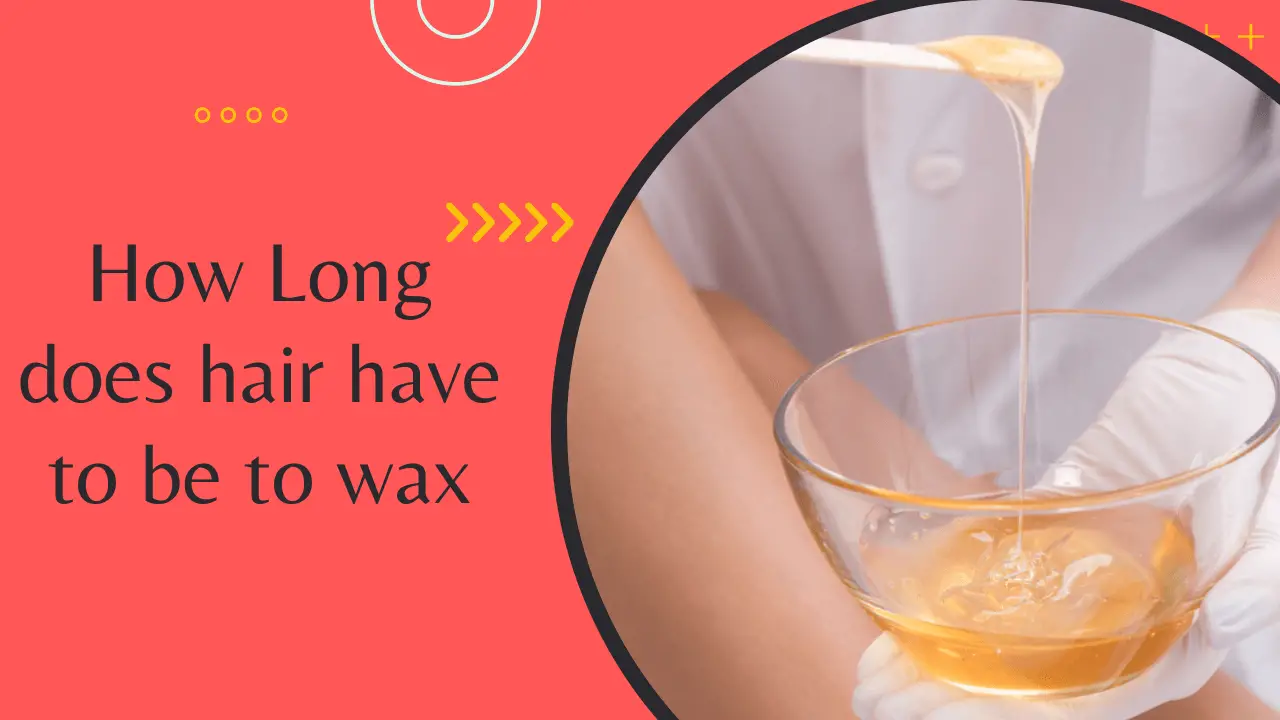Waxing is a popular way to get rid of unwanted hair, but figuring out the right hair length for waxing can be confusing. If your hair is too short, the wax won’t be able to grab onto it properly, and if it’s too long, it can be more painful and difficult to remove. Let’s explore in detail how long your hair should be before waxing, with advice from experts in the field.
How Long Does Hair Have to Be to Wax?
Before waxing, your hair needs to be at least 1/4 inch long, which is about the size of a grain of rice. This length ensures that the wax can grip the hair firmly and pull it out from the root, giving you smooth skin.
If it’s your first-time waxing, try to let your hair grow for about two weeks since your last hair removal session. But remember, everyone’s hair grows at different rates, so you might need to wait longer if your hair grows slowly.
To check if your hair is long enough, gently pull it up. If you can’t grab onto the hair without pinching your skin, it’s probably not long enough yet. Avoid pulling too hard to prevent accidentally removing the hair completely.
Does Hair Length Vary by Area?
Yes, the rate at which hair grows and its thickness can vary depending on which part of your body it’s on. For example, your underarm or pubic hair might grow faster and thicker compared to the hair on your arms or legs.
In areas where the hair is thicker, you might need to let it grow out a bit longer so that the wax can stick to it properly and prevent breakage.
Why Hair Length Matters?
For waxing to be effective, the wax needs to stick to the hair so it can be pulled out from the root. If the wax doesn’t stick properly, it might not remove the hair completely, which can lead to breakage or irritation of the skin.
Making sure your hair is the right length also helps synchronize the hair growth cycles, which means your hair will grow back evenly.
Optimal Timing Between Sessions
How often you need to wax depends on how fast your hair grows. On average, it takes about four weeks for hair to grow back to 1/4 inch length after waxing.
Some people may notice that their hair grows back slower and thinner with regular waxing, which means they can wait longer between sessions, typically around 5 or 6 weeks.
Waxing Equipment
Here are some common tools used for waxing:
|
Equipment |
Description |
|
Wax Warmer |
Heats wax to the right temperature for use. |
|
Waxing Strips |
Used to remove wax and hair from the skin. |
|
Wooden Spatula |
Applies wax evenly onto the skin. |
|
Pre-Wax Cleanser |
Removes oils and debris from the skin before waxing. |
|
Post-Wax Oil |
Soothes and moisturizes the skin after waxing. |
How to Wax Hair? [Step-by-Step Guide to Waxing]

Here are the steps that you need to carefully follow when waxing hair:
Step 1. Prepare Your Skin
Clean the area to be waxed with a pre-wax cleanser to remove any oils or residues.
Step 2. Heat the Wax
Place the wax container in a wax warmer and heat it to the right temperature.
Step 3. Test the Temperature
Before applying the wax to your skin, test a small amount on your wrist to make sure it’s not too hot.
Step 4. Apply the Wax
Use a wooden spatula to apply a thin layer of wax in the direction of hair growth. Avoid applying wax over the same area multiple times.
Step 5. Place the Strip
Immediately place a waxing strip over the waxed area and press it down firmly.
Step 6. Remove the Strip
Hold the skin taut with one hand and use the other hand to quickly pull off the strip against the direction of hair growth.
Step 7. Repeat as Needed
Continue waxing in small sections until you’ve removed all the desired hair.
Step 8. Clean Up
Use post-wax oil to remove any wax residue and soothe the skin.
Step 9. Moisturize
After waxing, apply a lightweight moisturizer to keep the skin hydrated.
What to Do Between Waxes?
During the time between waxes, it can be tempting to resort to shaving or plucking when your hair grows longer than you’d like. However, these methods can prolong the time between waxes and potentially irritate your skin.
Instead, focus on exfoliating regularly to keep your hair follicles clear of dead skin and debris. This not only prepares your skin for the next waxing session but also helps maintain smoother results in the long run.
Consequences of Waxing Too Early
If your hair is shorter than 1/4 inch, waxing won’t work well. Your technician will probably suggest rescheduling your appointment to give your hair more time to grow.
Waxing too early can result in the hair not being removed properly, breakage, and possible skin irritation or ingrown hairs.
Can Hair Be Too Long?
Yes, hair can definitely be too long for waxing. If your hair is longer than 1/2 inch, it might be too long for the wax to grip properly.
In such cases, you can trim the hair lightly before your appointment using clean hair cutting scissors. Alternatively, your technician can trim it for you during the appointment based on their assessment.
How Long Does Waxing Last?
The duration of waxing results varies from person to person and depends on which part of the body was waxed. Generally, waxing can last three to four weeks, but it may differ for different areas:
- Underarms: Every two weeks for consistent smoothness.
- Bikini Area: Every two to four weeks, depending on the style of waxing.
- Legs: Every three to four weeks for optimal regrowth.
- Chest: Typically every six weeks.
- Butt: Every three to four weeks, if included in a waxing session.
- Face: Every two to three weeks due to faster hair growth.
Mistakes to Avoid When Waxing
1. Waxing Over the Same Area Repeatedly
Applying wax multiple times over the same area can irritate the skin and increase the risk of hair breakage.
Ensure you apply wax in a thin, even layer and only remove it once with a waxing strip to minimize discomfort and achieve smooth results.
2. Ignoring Skin Sensitivity
Neglecting to consider skin sensitivity can lead to painful waxing experiences and potential skin damage. It’s essential to test the wax temperature before applying it to ensure it’s comfortable for your skin.
Additionally, using pre-wax products to cleanse and prep the skin can help minimize irritation.
3. Pulling the Strip Incorrectly
Incorrectly pulling the waxing strip can result in ineffective hair removal and increased discomfort. Always pull the strip quickly and in the opposite direction of hair growth, keeping the skin taut with your free hand. This technique helps to remove hair from the root efficiently while minimizing pain.
4. Waxing Hair That’s Too Short
Attempting to wax hair that’s shorter than the recommended length can lead to incomplete hair removal and skin irritation.
Ensure your hair is at least 1/4 inch long before waxing to allow the wax to grip the hair effectively. Waiting for proper hair growth ensures smoother results and reduces the risk of ingrown hairs.
5. Skipping Post-Wax Care
Neglecting post-wax care can result in skin irritation, ingrown hairs, and uneven skin texture. After waxing, soothe the skin with a post-wax oil or lotion to calm inflammation and moisturize the skin.
Exfoliating regularly between waxing sessions can also help prevent ingrown hairs and promote smooth, healthy skin.
Conclusion
Waxing can be an effective way to remove unwanted hair, but getting the hair length right is crucial for success. As you follow these guidelines on hair length, scheduling, and preparation, you can achieve smooth and long-lasting results with minimal discomfort.
If you have any questions or concerns, don’t hesitate to consult with your waxing technician for personalized advice. Know that finding the right waxing routine for you is key to maintaining silky-smooth skin year-round.
Frequently Asked Questions
Can I Wax if My Hair is Too Long?
Waxing hair that’s too long can be challenging and more painful. It’s best to trim long hair to the recommended length before waxing, typically no longer than 1/2 inch. This ensures effective hair removal and reduces discomfort during the waxing process.
Is Waxing Painful?
While waxing may cause some discomfort, especially for first-timers, it’s generally tolerable and becomes less painful with regular sessions. Applying wax at the right temperature, pulling the strip quickly, and using proper techniques can help minimize discomfort and ensure smoother results.
Can I Wax at Home or Should I Visit a Professional?
Both options are viable, depending on your preference and experience level. Waxing at home can be convenient and cost-effective, but it requires proper technique and caution to avoid mistakes. Visiting a professional waxing salon ensures expert handling and may be preferable for those new to waxing or sensitive areas like the bikini line.

